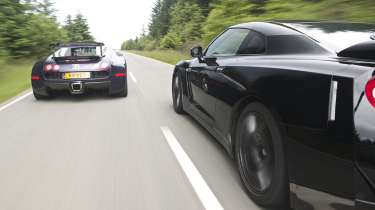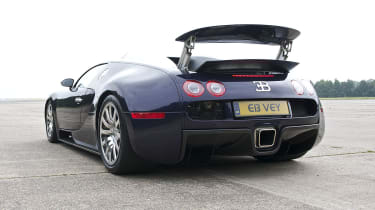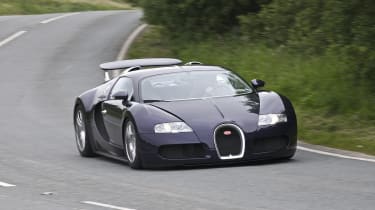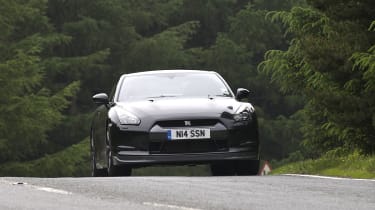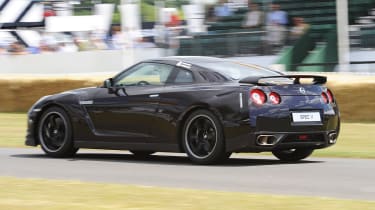Nissan GT-R v Bugatti Veyron
Nissan’s GT-R has been described as a baby Veyron, but is it really a match for the mighty Bugatti?
Let’s start by laying a myth to rest. You probably know the story, the one where a Bugatti Veyron gives a McLaren F1 a ten second head start in a drag race and still pips it to 200mph. The way the tale is told, the Veyron heroically claws back the distance between itself and the McLaren until, at 200mph, it pulls level, eyes momentarily lock across the shuddering air space, and then it’s gone, thundering on towards its 253mph top speed. Utter cobblers.
True, an early factory prediction for the Veyron’s 0-200mph time (sub 20 seconds) put it about 10 seconds under that independently recorded for the McLaren. But after 10 seconds the F1 is almost a quarter of a mile down the road and travelling at 130mph. Stupendous as the Veyron’s acceleration is, it won’t have caught the Macca when it hits 200mph. It might well be doing 200mph at the same moment, but it will be doing it in the F1’s mirrors. And as if the Veyron ever needed the helping hand of hype.
So we’ve come up with a better race, a better contest, and a better use of the Veyron’s (and its friendly owner Leigh’s) valuable time. As you’ll have seen from the photos, it involves a Nissan, so clearly there’s some explaining to do.
Now it’s fair to say that, since its launch in 2005, the Bugatti Veyron EB 16.4, to give it its full name, has polarised opinion. Some believe that when then Audi boss Ferdinand Piëch acquired Bugatti for the VW group and gave the green light to project Veyron, he simply wrote ‘world domination’ at the top of the job sheet, and that’s why it has 8 litres, 16 cylinders, four turbochargers, two intercoolers, ten radiators, a thousand horsepower, seven gears, two clutches, four-wheel drive, weighs nearly two tons despite having a carbon body and costs a million quid. In short, it’s nothing more than a cost-no-object means to an end that entails lots of preposterous numbers and the sort of bomb-proof, high-end engineering only a large German car company could provide. Plutocratic excess as the defining contribution to the evolution of the supercar? When you consider that the naturally aspirated, rear-drive McLaren’s prodigious performance was a consequence of Gordon Murray’s sublime design and purist principles, maybe not.
More reviews
Group tests
In-depth reviews
Reviews
- 2025 Nissan GT‑R Nismo Final Edition - Japan's 911 GT3 RS still has it
- Nissan GT-R Nismo (R35, 2014 - 2025) review – Godzilla on steroids is a Japanese icon
- 2017 Nissan GT-R review
- Nissan Skyline GT-R R32 - review, history, prices and specs
- Nissan GT-R review - The GT-R has never been more usable, yet it's still blisteringly fast
Then again, others will brook no argument over the Veyron. They say to hell with high-minded principles, the Bug is simply the most awesome, extreme, incredible, unforgettable supercar experience ever created, a machine of such crushing omnipotence that nothing else even comes close. This rings a few bells with us. What other car can you think of that has been engineered by a manufacturing giant with the prime aim of blitzing the opposition?
Yeah, a Nissan. Our current car of the year, the GT-R didn’t just tear up the rule book when it humbled the likes of the Gallardo LP560-4 and 911 GT2 in France last year, it put it through an industrial shredder. Some said it wasn’t a just result, complaining that the GT-R’s almost surreal A-to-B pace was too easy, too ‘contrived’ by Japanese boffins hunched over computer screens in a darkened room, that the car lacked any real depth of personality and that the Porsche or Lambo would be far more engaging and rewarding to drive quickly and to live with, never mind a Ferrari. Maybe that’s right, and maybe exactly the same could be said of the Veyron.
There are other parallels. Both cars look like nothing else on earth, for example. The jelly-mould Veyron eschews the bladed, weapon-like design language that has become an Italian supercar cliché, adopting instead an almost feminine elegance. In the Xena Warrior Princess sense. The GT-R, meanwhile, looks as unique as it does fascinating. Rather like the Ferrari California, most of its mass seems to be concentrated in its haunches, giving it the slab-muscled emphasis of a speed skater with grossly over-developed thighs. The rear panels in particular have a lot of surface area, yet none of it looks wrong. And it’s hard to argue with a Cd of 0.27, especially if you’re the Bugatti (0.36, even in low-drag mode).
Anyway, here it comes, a black speck approaching from the east at speed. Harry and I are sitting in the idling Veyron at the beginning of Bruntingthorpe’s two-mile runway while Ollie, in the GT-R, is about to hustle the Nissan through the long, sweeping right-hander that leads onto the straight with all the speed he and the Japanese assassin can muster – probably just nudging 100mph – and nail it. As the GT-R crosses my line of vision, I’ll do the same in the Veyron, and we’ll see just how long it takes to catch and overtake him. Any lingering doubts about the McLaren myth? Read on.
It will be more interesting now that the Bugatti’s launch control, having performed faultlessly to allow the Veyron to record 0-60mph in 2.8sec and 0-100 in 5.8 time after time an hour earlier, is refusing to engage in the growing heat of the day. We know this will add about half a second to its 0-60mph time, making it a mere half a second or so quicker over the sprint than the Nissan, which, once again, has defied all reason and posted acceleration times that jar with the 478bhp claimed for its twin-turbo 3.8-litre V6: sixty in 3.9 and the ton in 8.4sec are figures any 500bhp-plus supercar would be proud of. In the spirit of the exercise, we’ll call them the work of Veyron Lite.
Of course, Veyron Heavy will eat it alive. It will be like a bullet overtaking a firmly struck tennis ball. It has more than twice the power and torque and gets to 170mph in half the time. If a stationary Veyron really can run down a McLaren that’s got a 130mph jump on it, this should be a breeze. So here comes the GT-R and, hell, it’s moving. Wide line into the entry of the bend. I pull the Bugatti’s stubby DSG selector into Drive and nudge it to the right to engage Sport, switch to left foot on the brake. We watch the Nissan hunker down, bobbing slightly over some scars in the tarmac as its suspension compresses. I press down harder on the brake pedal and gently load up the W16 power station at my back. It wheezes and rumbles like a 747 taxiing for take-off.
Almost too soon the GT-R streaks across in front of the Veyron’s windscreen and spears onto the straight, its loaded tyres pulling a haze of dust from the road. God speed, Ollie. You’re going to need it. With no great urgency, I bury the accelerator. The Veyron chokes, gulps and for what seems an age, but is probably just a second, does nothing. This isn’t entirely unexpected. Without the help of launch control, Veyrons have been known to bog down. More breathing space for the Nissan.
Then something happens. Something big. When the moment arrives, and it’s immediately preceded by what feels like a rapid and enormous build-up of contained pressure, the Veyron cuts loose like no other supercar or hypercar on earth. It’s as if it’s being pushed from behind by a monumental shockwave of energy, the sort you might imagine having been generated by a strategically sited nuclear bomb. The experience is so stunning it could kill someone with a dicky heart. After just 12 seconds we’re doing 150mph. Four seconds later it’s 170mph, the shove in the back still palpable. The GT-R is now only the length of a football field ahead but the rate at which we’re closing it down is visibly slowing. Leigh had mentioned this earlier. It’s not as if the Veyron ‘hits the wall’ at 170, but the violence of its acceleration cools noticeably. No matter, Ollie’s toast. As the GT-R clicks up 175mph, we come past at 202mph, absolutely straight and stable, and there’s still plenty of room to brake without a hint of drama.
Harry and I are frankly amazed the GT-R took so much catching; at one point, we weren’t even sure we would. But then it was a proper handicapped drag race involving distance covered and not just elapsed time to a particular speed. Respect to the GT-R but, believe me, the way the Veyron made ground was awesome.
We finish off our morning with a few straight, side-by-side drag races and, predictably, the Veyron wastes the Nissan by such a ludicrous margin it’s hard not to laugh. As we strike out for north Wales and some of our favourite roads it occurs to us that while the GT-R clearly has strong echoes of the Bugatti’s design philosophy, and might justifiably be called a ‘poor man’s’ Veyron, it’s surely bitten off more than it can chew this time. It could be embarrassing.
FOR MOST OF THE JOURNEY to Conwy I drive the Veyron, with Leigh following in the GT-R. It’s not a quick run – too much summer traffic – but it is an illuminating one. With due allowance for scale and with the proviso that you sit very low to the road (ant antenna-skimmingly low with the suspension in Handling mode, which drops the ride height further and sticks the rear spoiler up), the Bugatti is as easy to drive slowly as the old Audi TT that Harry has brought along for the ride. Comfortable seats, great driving position, fine visibility, smooth transmission, light steering. Too light, actually, at these sorts of speeds, and largely without feel. But very precise. The Veyron can be positioned on the road with impressive accuracy, which is just as well considering its width.
Out of the tumult of sensations, three thoughts crystallise as I drive: the ride is very, very firm but body control absolute; tyre noise on coarse surfaces can get almost maddeningly loud; and, for a car that weighs 2022kg, it feels unfathomably manageable, gripping, changing direction and stopping with a sense of unlimited resolve that gives you a huge shot of confidence. Considering the masses and forces it has to cope with, of course, the suspension has to be that uncompromising, the rubber footprint that immense. It could so easily be clumsy but, instead, the Veyron is amazingly agile, reflexive and biddable. At the same time, though, there’s something missing: a texture, a timbre, a loveable quirk that makes being in a Porsche, Lamborghini or Ferrari a special and distinctive experience. In this respect the Veyron is a bit matter-of-fact – rather cold and clinical.
But then much the same can be said of the GT-R. It too is capable of astonishing feats, but the ‘charisma thing’ doesn’t figure prominently. Certainly, the anodyne, amorphous whoosh of the Nissan’s engine has no discernible musical content and the way the double-clutch gearbox makes acceleration one seamless surge rather than a series of punchy lunges is more effective than it is evocative. That said, some pretty stark contrasts are laid bare as I take the wheel for our drive to the beach at Porthmadog: the vastly loftier seating position, the much heavier and more feel-full steering and the incomparably better ride. Generally, it’s the more comfortable, relaxing car. Unless you’re pulling away from rest. The Veyron does it with the silky smoothness of an S-class, the GT-R with all the subtlety of a newly hitched railway carriage taking up the slack. It will teach you degrees of right-foot delicacy you never knew you had.
It’s deceptive, though, the GT-R. It gives a convincing impression of being a docile pooch much of the time, but show it a fast, challenging road – one with open sight-lines and decent straights but defined by its tortured serpentine nature – and it becomes the attack dog from hell. Such a road occurs on the route to our overnight hotel. We get to it just as dusk is falling, and pull over for a few minutes to assess the situation. There are no other cars around, so we decide to go for it. As I know the road, I’ll lead in the GT-R. But Leigh knows his car and it has 522bhp more than mine. Neither of us is prepared to call how this one will go.
Except that, frankly fearful of being chased by the fastest supercar the world has ever seen, I run to the Nissan, hit the start button and give it the full beans up to and through the first bend. It buys me about 200 metres. Then it’s simply a matter of driving as if I’m being chased by a madman wielding an AK-47. There is no car I know of that is better for acting out this imaginary scenario than the GT-R. You could be driving in a state of utter terror, feeding purely off reactions and adrenalin, and the GT-R will translate it into stunning speed across the ground. It minimises mistakes, rewards aggression and commitment, makes you better than you are. More than that, it makes you feel better than your are.
I’ve set everything to ‘Race’ and have decided I have no option but to punt the Nissan with the sort of sinew-wringing desperation I’d normally reserve for a Panda 100HP. I’m applying so much pressure to the accelerator and brake pedal that a couple of days later I’ll wake up with an aching right leg. Hard on the throttle, hard on the brakes, nothing in between. Well, it worked for Jim Clark.
I’m staggered at the sustained speed, the instant, lag-free urge, the way the chassis ignores the road’s humps, dips, kinks and cambers, carrying absurd pace through the trickiest of bends with complete equanimity. Yet, at any moment, I’m expecting to feel the warmth of the Veyron’s headlight beams on the back of my neck. It never comes; the Bugatti never closes that initial 200-metre gap. When we stop to swap thoughts, it’s hard not to conclude that the GT-R has exposed the Veyron’s Achilles heel. On this kind of road, at least, the Bugatti is too heavy, too prone to scrape its chin on the deck, too expensive to explore its limits with brain-out abandon. Only its astonishing straight-line acceleration kept it in touch, but it could do nothing to close the gap.
The Veyron is easy to drive. If it didn’t have a boot the size of a lunchbox, you could go shopping in it. It’s also easy to drive at speeds to which other mainstream supercars have no answer. All you need to do is keep your spatial awareness on its most sensitive setting, because you will arrive at corners travelling more quickly than you ever thought possible. What is clear, though, is that on the right road, and if you’re prepared to drive it to within an inch of its life, the Nissan GT-R will look after yours and cover the ground so rapidly that it bows to no supercar, not even the mighty Veyron.
Table below shows the Bugatti’s crushing straight-line performance – and these figures were recorded in the car’s standard driving mode. If its low-drag set-up had been engaged with the special ‘high-speed key’ it would have been quicker still to the double ton…
Lap Times
| Performance | Veyron | Nissan GT-R |
| 0-30 | 1.4 | 1.8 |
| 0-40 | 1.9 | 2.4 |
| 0-50 | 2.3 | 3.1 |
| 0-60 | 2.8 | 3.9 |
| 0-70 | 3.4 | 4.8 |
| 0-80 | 4.1 | 5.9 |
| 0-90 | 4.9 | 7.1 |
| 0-100 | 5.8 | 8.4 |
| 0-110 | 6.7 | 10 |
| 0-120 | 7.9 | 11.7 |
| 0-130 | 9.1 | 14.2 |
| 0-140 | 10.5 | 17.2 |
| 0-150 | 12 | 20.6 |
| 0-160 | 13.9 | 25.3 |
| 0-170 | 16.2 | 32.8 |
| 0-180 | 19.1 | - |
| 0-190 | 23 | - |
| 0-200 | 28.6 | - |
| 1/4 mile sec | 10.5 | 12.1 |
| 1/4 mile mph | 140.2 | 121.1 |
| Braking | ||
| 60-0 | 2.7 | 2.6 |
| dist. ft | 102.8 | 99 |
| 100-0 | 4.3 | 4.1 |
| dist. ft | 293.6 | 272.5 |
Comparison
| Veyron | Nissan GT-R | |
| Engine | W16, quad-turbo | V6, twin-turbo |
| Location | Mid, longitudinal | Front, longitudinal |
| Displacement | 7993cc | 3799cc |
| Cylinder block | Aluminium alloy, dry sumped | Aluminium alloy |
| Cylinder head | Aluminium alloy, dohc per bank, four valves per cylinder, variable valve timing | Aluminium alloy, dohc per bank, four valves per cylinder, variable valve timing |
| Max power | 1000bhp @ 6000rpm | 478bhp @ 6400rpm |
| Max torque | 922lb ft @ 2200-5500rpm | 433lb ft @ 3200-5200rpm |
| Transmission | Seven-speed dual-clutch gearbox, four-wheel drive, rear limited-slip differential, ESP | Six-speed dual-clutch gearbox, ATTESA ET-S four-wheel drive, rear limited-slip diff, VDC-R |
| Front suspension | Double wishbones, coil springs, electronic dampers, anti-roll bar | Double wishbones, coil springs, DampTronic dampers, arb |
| Rear suspension | Double wishbones, coil springs, electronic dampers, anti-roll bar | Multi-link, coil springs, DampTronic dampers, arb |
| Brakes | Carbon-ceramic discs, 400mm front, 380mm rear, ABS | Ventilated and cross-drilled discs, 380mm front and rear, ABS, BA, EBD, Preview Braking |
| Wheels | 19.7in diameter front, 21.25in rear, aluminium alloy | 9.5 x 20in front, 10.5 x 20in rear, aluminium alloy |
| Tyres | Michelin PAX system; 265-680 front, 365-710 rear | 255/40 ZR20 front, 285/35 ZR20 rear, Dunlop SP Sport 600 DSST |
| Weight (kerb) | 1950kg (test weight 2022kg) | 1740kg (test weight 1741kg) |
| Power-to-weight | 521bhp/ton | 279bhp/ton |
| 0-62mph | 2.5sec (mfr’s figure) | 3.6sec (mfr’s figure) |
| Top speed | 253mph (claimed) | 193mph (claimed) |
| Basic price | 1.2 million euros (plus local taxes) | £56,795 |
| Evo rating | 5/5 | 5/5 |
